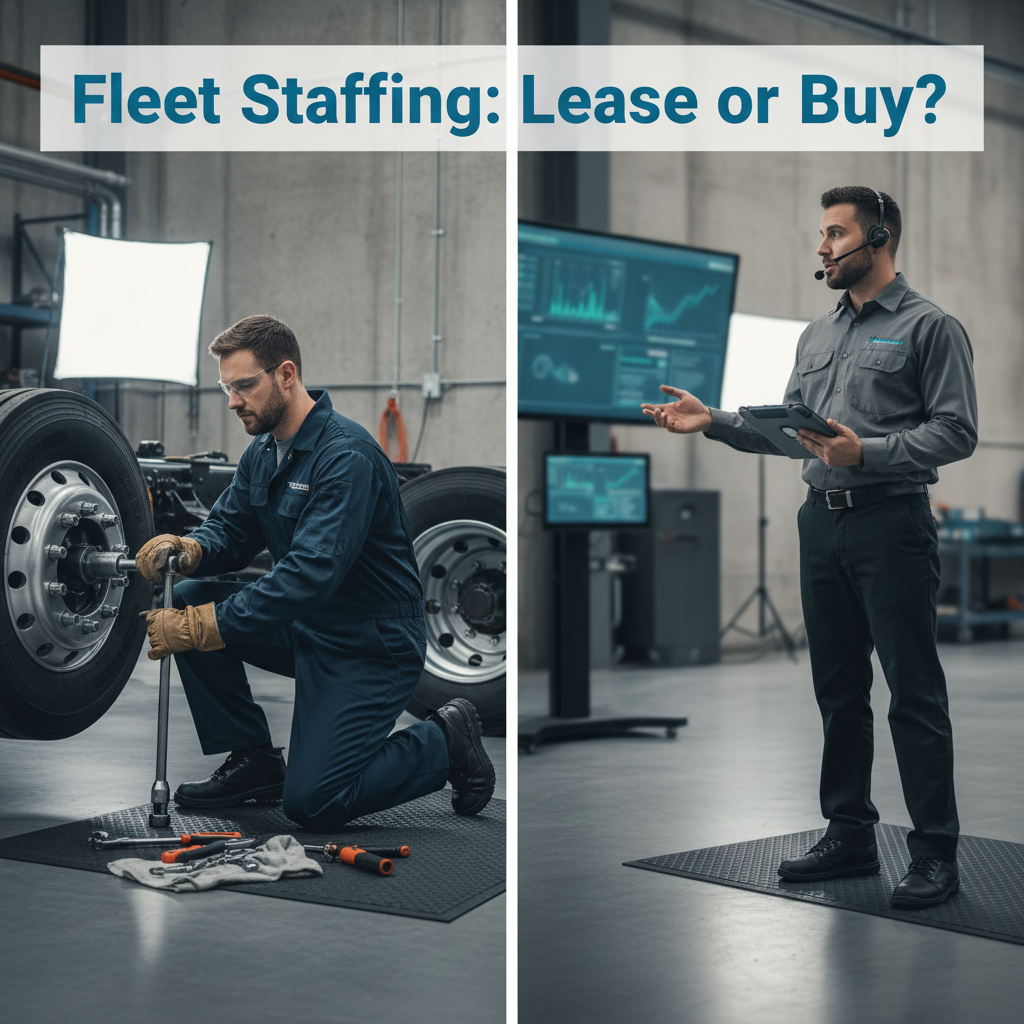As a fleet manager or business owner, you've debated it a thousand times: is it better to lease or buy your vehicles? You've run the numbers on capital expenditure, depreciation, and maintenance costs. But there's a critical factor that rarely makes it onto the spreadsheet: your people.
Table of Contents
The decision to lease or buy your fleet has a direct and profound impact on your ability to recruit, train, and retain the skilled mechanics who keep your business moving.
This isn't just a financial decision; it's a workforce strategy. Choosing the wrong path for your company's situation can lead to crippling technician shortages, extended vehicle downtime, and skyrocketing recruitment costs. Here, we'll break down how to look beyond the balance sheet and make a choice that sets both your fleet and your team up for success.
The Talent & Workforce Impact of Your Fleet Decision
Every fleet manager knows the lease vs. buy decision impacts the balance sheet. But its effect on your team—the skilled technicians who keep your operation running—is often overlooked until it's too late.
| Fleet Strategy | Impact on Workforce | Primary Challenge |
|---|---|---|
| Buying Your Fleet | Requires building an in-house team of mechanics who develop deep, specialized knowledge of your vehicles. | Successfully recruiting, training, and retaining skilled technicians in a competitive market. |
| Leasing Your Fleet | Your team's role shifts from hands-on repair to vendor management, advanced diagnostics, and quality control. | Ensuring the leasing company meets service-level agreements (SLAs) and managing the team's skill evolution. |
The evolving complexity of modern vehicles, including hybrids, EVs, and advanced driver-assist systems, necessitates a significant mechanic skill evolution. As Apex Technical School highlights, modern technicians require proficiency in advanced diagnostic tools and continuous education to handle electronic and computer-driven systems, shifting their role towards data analysis and engineering-like approaches, moving beyond traditional mechanical repairs. This fundamental change is reshaping what it means to be a mechanic in the modern workforce.
Uncovering the Hidden Costs & True ROI
The financial models for leasing versus buying often miss the most significant variable: the people. Calculating the true ROI requires looking beyond the monthly payment or initial purchase price.
The Real Cost of an In-House Maintenance Team
Building your own team is a significant investment. The recruitment costs for mechanics, particularly for specialized roles, can be significant. AutoMarket reports that while general costs for hiring a skilled trades worker average over $12,000, dealership-specific mechanic hires can average around $10,000, and using a recruiting agency can cost 15-25% of the mechanic's first-year salary. Consider these ongoing expenses:
* Salaries and Benefits: The direct compensation for your team.
* Technician Training and Development: Modern vehicles require continuous education on new technologies like telematics and EV systems.
* Tools and Equipment: A constant capital expense to keep your shop up-to-date.
* The Cost of an Empty Bay: According to L'Automobile Magazine, a single vacant technician bay can cost a company between $1,500 and $2,000 per day in lost revenue, including unbilled labor, missed parts sales, and lost upsell opportunities. This is the hidden cost of slow recruitment. MasterTech's internal data shows that each week a diesel technician position remains unfilled can cost a business an estimated $5,000 in lost productivity and revenue.
The ROI of a Strategic Staffing Partner
Whether you buy and need to build a team or lease and need to adapt your current one, the core challenge is the same: finding the right talent. The ROI of your fleet decision is directly tied to your fleet maintenance staffing strategy.
A specialized recruitment partner helps you:
* Reduce Downtime: Fill open positions faster to keep your bays productive.
* Improve Retention: Find technicians who are a cultural and technical fit, reducing turnover costs.
* Access Top Talent: Tap into a network of skilled professionals you couldn't reach on your own.
For instance, a recent MasterTech client reduced their technician vacancy rate by 40% in just three months, significantly improving fleet availability and revenue generation.
Integrating Workforce Planning into Your Fleet Strategy
Your fleet acquisition model and your talent strategy must be aligned. Making this decision in a silo is a recipe for operational headaches and budget overruns.
Aligning Operations, Finance, and HR
The decision to lease or buy shouldn't just be made by the CFO and the Director of Operations. Your HR or talent acquisition leader needs a seat at the table.
* Analyze Your Local Talent Pool: Are skilled diesel technicians readily available in your area, or is the market incredibly tight?
* Assess Your Current Team's Skillset: Can your existing mechanics adapt to the diagnostic and administrative roles required by a leasing model?
* Forecast Future Needs: Consider how a shift to electric or autonomous vehicles will impact your long-term workforce planning for fleets.
Making the Right Choice for Your Business
There is no one-size-fits-all answer. The right choice depends on your unique operational needs, financial goals, and, most importantly, your talent landscape.
| Choose This Strategy... | ...If Your Business Situation Is: |
|---|---|
| Buying Your Fleet | You have a strong culture, are committed to employee development, and see your in-house maintenance team as a competitive advantage. The local talent market is accessible. |
| Leasing Your Fleet | You operate in a highly competitive talent market, want predictable maintenance costs, and prefer to focus capital on core business operations. |
Ultimately, understanding the lease vs. buy impact on technicians is the key to making a decision that benefits your vehicles, your team, and your bottom line.


.png)
.svg)
